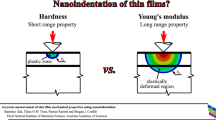Abstract
A phenomenological model is proposed for describing the hysteretic behavior in an adhesive contact between a soft elastomer and a hard indenter upon a change in the indenter direction of motion. The model takes into account the increase in the contact strength with increasing contact time. Dependences of the elastic force and the contact radius on the indentation depth are obtained. It is shown that the adhesive strength of the contact increases with the indentation depth. An experiment on intrusion of a spherical steel indenter into a rubber sheet of a fixed thickness is performed. It is shown that the experimental and theoretical results coincide qualitatively.










Similar content being viewed by others
Notes
In this article, we describe the experiment with an indenter of radius R = 22 mm, while in our earlier similar experiment [25], the indenter radius was R = 40 mm. Because of the larger indenter radius in the experiment described in [25], the value of Fmin = –5.24 mN averaged over six experiments was realized at the indentation stage. With account for the indenter radius, this gives the value of γeff, 1 = 0.031 J/m2, which is close to the value obtained in the present study.
REFERENCES
S. Gorb, Adhesion and Friction in Biological Systems (Springer, Netherlands, 2012).
M. Ciavarella, J. Joe, A. Papangelo, and J. R. Barber, J. R. Soc., Interface 16 (151), 20180738 (2019). https://doi.org/10.1098/rsif.2018.0738
P. Schmitt, D. Eberlein, C. Ebert, M. Tranitz, I. Eitner, and H. Wirth, Energy Procedia 38, 380 (2013). https://doi.org/10.1016/j.egypro.2013.07.293
A. I. Dmitriev, A. Y. Nikonov, and W. Österle, Lubricants 4 (3), 24 (2016). https://doi.org/10.3390/lubricants4030024
G. Carbone, E. Pierro, and S. N. Gorb, Soft Matter 7 (12), 5545 (2011). https://doi.org/10.1039/C0SM01482F
K. L. Johnson, K. Kendall, and A. D. Roberts, Proc. R. Soc. London, Ser. A 324 (1558), 301 (1971). https://doi.org/10.1098/rspa.1971.0141
B. V. Derjaguin, V. M. Muller, and Y. P. Toporov, J. Colloid Interface Sci. 53 (2), 314 (1975). https://doi.org/10.1016/0021-9797(75)90018-1
D. Maugis, J. Colloid Interface Sci. 150 (1), 243 (1992). https://doi.org/10.1016/0021-9797(92)90285-T
E. Popova and V. L. Popov, Phys. Mesomech. 21 (1), 1 (2018). https://doi.org/10.1134/S1029959918010010
J. Joe, J. R. Barber, and M. D. Thouless, Front. Mech. Eng. 6, 31 (2020). https://doi.org/10.3389/fmech.2020.00031
W. Deng and H. Kesari, Sci. Rep. 9, 1639 (2019). https://doi.org/10.1038/s41598-018-38212-z
L. Pastewka and M. O. Robbins, Proc. Natl. Acad. Sci. U.S.A. 111 (9), 3298 (2014). https://doi.org/10.1073/pnas.1320846111
R. W. Style, C. Hyland, R. Boltyanskiy, J. S. Wettlaufer, and E.R. Dufresne, Nat. Commun. 4, 2728 (2013). https://doi.org/10.1038/ncomms3728
S. Karpitschka, L. van Wijngaarden, and J. H. Snoeijer, Soft Matter 12 (19), 4463 (2016). https://doi.org/10.1039/C5SM03079J
J. Long, G. Wang, X. Feng, and S. Yu, Int. J. Solids Struct. 84, 133 (2016). https://doi.org/10.1016/j.ijsolstr.2016.01.021
A. Papangelo, J. Scheibert, R. Sahli, G. Pallares, and M. Ciavarella, Phys. Rev. E 99 (5), 053005 (2019). https://doi.org/10.1103/PhysRevE.99.053005
J. Scheibert, R. Sahli, and M. Peyrard, Front. Mech. Eng. 6, 18 (2020). https://doi.org/10.3389/fmech.2020.00018
B. Lorentz and A. Albers, Tribol. Int. 59, 259 (2013). https://doi.org/10.1016/j.triboint.2012.08.023
A. I. Dmitriev, A. Y. Nikonov, and W. Österle, Lubricants 6 (2), 43 (2018). https://doi.org/10.3390/lubricants6020043
J. F. Waters and P. R. Guduru, Proc. R. Soc., Ser. A 466 (2117), 1303 (2010). https://doi.org/10.1098/rspa.2009.0461
J. F. Waters and P. R. Guduru, Proc. R. Soc., Ser. A 467 (2132), 2209 (2011). https://doi.org/10.1098/rspa.2010.0617
J. F. Waters, J. Kalow, H. Gao, and P. R. Guduru, J. Adhesion 88 (2), 134 (2012). https://doi.org/10.1080/00218464.2012.648061
J. F. Waters, H. J. Gao, and P. R. Guduru, J. Adhesion 87 (3), 194 (2011). https://doi.org/10.1080/00218464.2011.557325
I. A. Lyashenko and V. L. Popov, AIP Conf. Proc. 2167 (1), 020201 (2019). https://doi.org/10.1063/1.5132068
I. A. Lyashenko and V. L. Popov, Tech. Phys. 65 (10), 1695 (2020). https://doi.org/10.1134/S1063784220100126
I. Argatov, Facta Univ., Ser. Mech. Eng. 17 (2), 181 (2019). https://doi.org/10.22190/FUME190330024A
V. L. Popov, M. Heß, and E. Willert, Handbook of Contact Mechanics: Exact Solutions of Axisymmetric Contact Problems (Springer, Berlin, 2019). https://doi.org/10.1007/978-3-662-58709-6
M. Heß, Über die exakte Abbildung ausgewählter dreidimensionaler Kontakte auf Systeme mit niedrigerer räumlicher Dimension (Cuvillier, Berlin, 2011). ISBN: 978-3869558233
I. A. Lyashenko and Z. M. Liashenko, Ukr. J. Phys. 65 (3), 205 (2020). https://doi.org/10.15407/ujpe65.3.205
Z. Liu, H. Lu, Y. Zheng, D. Tao, Y. Meng, and Y. Tian, Sci. Rep. 8, 6147 (2018). https://doi.org/10.1038/s41598-018-24587-6
V. L. Popov, AIP Conf. Proc. 2167 (1), 020286 (2019). https://doi.org/10.1063/1.5132153
S. Dalvi, A. Gujrati, S. R. Khanal, L. Pastewka, A. Dhinojwala, and T. D. B. Jacobs, Proc. Natl. Acad. Sci. U.S.A. 116 (51), 25484 (2019). https://doi.org/10.1073/pnas.1913126116
Q. Li, R. Pohrt, and V. L. Popov, Front. Mech. Eng. 5, 7 (2019). https://doi.org/10.3389/fmech.2019.00007
H. Kesari, J. C. Doll, B. L. Pruitt, W. Cai, and A. L. Lew, Philos. Mag. Lett. 90 (12), 891 (2010). https://doi.org/10.1080/09500839.2010.521204
I. A. Lyashenko and V. L. Popov, Tech. Phys. Lett. 46 (11), 1092 (2020). https://doi.org/10.1134/S1063785020110097
https://www.k-tanac.co.jp/crystalnone
Q. Li, R. Pohrt, I. A. Lyashenko, and V. L. Popov, Proc. Inst. Mech. Eng., Part J 234 (1), 73 (2020). https://doi.org/10.1177/1350650119854250
J. A. Greenwood, Tribol. Lett. 65, 159 (2017). https://doi.org/10.1007/s11249-017-0938-1
I. A. Lyashenko and R. Pohrt, Front. Mech. Eng. 6, 49 (2020). https://doi.org/10.3389/fmech.2020.00049
A. Papangelo, Facta Univ., Ser. Mech. Eng. 16, 19 (2018). https://doi.org/10.22190/FUME180102008P
H. Hertz, J. Reine Angew. Math. 92, 156 (1882). https://doi.org/10.1515/crll.1882.92.156
V. R. Regel’, A. I. Slutsker, and E. E. Tomashevskii, Kinetic Nature of the Strength of Solids (Nauka, Moscow, 1974) [in Russian].
V. A. Petrov, A. Ya. Bashkarev, and V. I. Vettegren’, Physical Foundations of Prediction of the Durability of Structural Materials (Politekhnika, St. Petersburg, 1993) [in Russian].
V. L. Popov, Preprints No. 2020030131 (2020). https://doi.org/10.20944/preprints202003.0131.v1
I. Argatov, M. Heß, and V. L. Popov, J. Appl. Math. Mech. 98 (4), 622 (2018). https://doi.org/10.1002/zamm.201700213
Funding
This study was supported by the Deutsche Forschungsgemeinschaft, project RO 810-55-1.
Author information
Authors and Affiliations
Corresponding author
Ethics declarations
The authors declare that they have no conflict of interest.
Additional information
Translated by N. Wadhwa
Rights and permissions
About this article
Cite this article
Lyashenko, I.A., Popov, V.L. Hysteresis in an Adhesive Contact upon a Change in the Indenter Direction of Motion: an Experiment and Phenomenological Model. Tech. Phys. 66, 611–629 (2021). https://doi.org/10.1134/S1063784221040113
Received:
Revised:
Accepted:
Published:
Issue Date:
DOI: https://doi.org/10.1134/S1063784221040113




